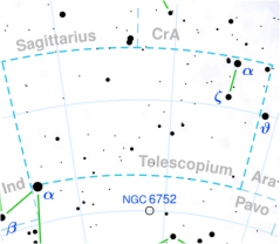Astronomy:HD 193002
| Observation data Epoch J2000.0 Equinox (celestial coordinates) | |
|---|---|
| Constellation | Telescopium |
| Right ascension | 20h 20m 32.31401s[1] |
| Declination | −55° 03′ 03.1837″[1] |
| Apparent magnitude (V) | 6.26±0.01[2] |
| Characteristics | |
| Evolutionary stage | AGB[3] |
| Spectral type | M0/1 III[4] |
| U−B color index | +2.01[5] |
| B−V color index | +1.59[5] |
| Variable type | suspected[6] |
| Astrometry | |
| Radial velocity (Rv) | −9.1±0.4[7] km/s |
| Proper motion (μ) | RA: +9.106[1] mas/yr Dec.: −33.290[1] mas/yr |
| Parallax (π) | 3.1785 ± 0.0411[1] mas |
| Distance | 1,030 ± 10 ly (315 ± 4 pc) |
| Absolute magnitude (MV) | −0.93[8] |
| Details | |
| Mass | 1.08[9] M☉ |
| Radius | 84.5±4.3[10] R☉ |
| Luminosity | 711[11] L☉ |
| Surface gravity (log g) | 0.87[9] cgs |
| Temperature | 3,972±122[12] K |
| Metallicity [Fe/H] | +0.07[9] dex |
| Other designations | |
| Database references | |
| SIMBAD | data |
HD 193002 (HR 7758; NSV 25094) is a solitary red hued star located in the southern constellation Telescopium. It has an apparent magnitude of 6.26,[2] placing it near the limit for naked eye visibility, even under ideal conditions. The object is located relatively far at a distance of 1,030 light years based on Gaia DR3 parallax measurements,[1] but it is approaching the Solar System with a heliocentric radial velocity of −9.1 km/s.[7] At its current distance, HD 193002's brightness is diminished by 0.17 magnitudes due to interstellar dust[14] and it has an absolute magnitude of −0.93.[8]
HD 193002 has a stellar classification of M0/1 III,[4] indicating that it is an evolved red giant with the characteristics of an M0 and M1 giant star. It is currently on the asymptotic giant branch,[3] generating fusion via hydrogen and helium shells around an inert carbon core. It has a comparable mass to the Sun[9] but it has expanded to 84.5 times the radius of the Sun.[10] It radiates 711 times the luminosity of the Sun[11] from its enlarged photosphere at an effective temperature of 3,972 K.[12] HD 193002 is slightly metal enriched with an iron abundance 118% that of the Sun's or [Fe/H] = +0.07.[9]
HD 193002 was first suspected to be variable in 1997 by the Hipparcos satellite.[16] It fluctuates between 6.34 and 6.39 in the Hipparcos passband.[6]
References
- ↑ 1.0 1.1 1.2 1.3 1.4 Vallenari, A. et al. (2022). "Gaia Data Release 3. Summary of the content and survey properties". Astronomy & Astrophysics. doi:10.1051/0004-6361/202243940 Gaia DR3 record for this source at VizieR.
- ↑ 2.0 2.1 Høg, E.; Fabricius, C.; Makarov, V. V.; Urban, S.; Corbin, T.; Wycoff, G.; Bastian, U.; Schwekendiek, P. et al. (March 2000). "The Tycho-2 catalogue of the 2.5 million brightest stars". Astronomy and Astrophysics 355: L27–L30. ISSN 0004-6361. Bibcode: 2000A&A...355L..27H.
- ↑ 3.0 3.1 Eggen, Olin J. (July 1992). "Asymptotic giant branch stars near the sun". The Astronomical Journal 104: 275. doi:10.1086/116239. ISSN 0004-6256. Bibcode: 1992AJ....104..275E.
- ↑ 4.0 4.1 Houk, N.; Cowley, A. P. (1975). University of Michigan Catalogue of two-dimensional spectral types for the HD stars: Declinations −90° to −53°. 1. Bibcode: 1975mcts.book.....H.
- ↑ 5.0 5.1 Oja, T. (1970). "UBV-Fotometri danska Tel (ESO)". Private Communication: 0. Bibcode: 1970Priv.........0O.
- ↑ 6.0 6.1 Samus’, N. N.; Kazarovets, E. V.; Durlevich, O. V.; Kireeva, N. N.; Pastukhova, E. N. (January 2017). "General catalogue of variable stars: Version GCVS 5.1". Astronomy Reports 61 (1): 80–88. doi:10.1134/S1063772917010085. ISSN 1063-7729. Bibcode: 2017ARep...61...80S.
- ↑ 7.0 7.1 Gontcharov, G. A. (November 2006). "Pulkovo Compilation of Radial Velocities for 35,495 Hipparcos stars in a common system". Astronomy Letters 32 (11): 759–771. doi:10.1134/S1063773706110065. ISSN 1063-7737. Bibcode: 2006AstL...32..759G.
- ↑ 8.0 8.1 Anderson, E.; Francis, Ch. (May 2012). "XHIP: An extended hipparcos compilation". Astronomy Letters 38 (5): 331–346. doi:10.1134/S1063773712050015. ISSN 1063-7737. Bibcode: 2012AstL...38..331A.
- ↑ 9.0 9.1 9.2 9.3 9.4 Anders, F. et al. (August 2019). "Photo-astrometric distances, extinctions, and astrophysical parameters for Gaia DR2 stars brighter than G = 18". Astronomy & Astrophysics 628: A94. doi:10.1051/0004-6361/201935765. ISSN 0004-6361. Bibcode: 2019A&A...628A..94A.
- ↑ 10.0 10.1 Kervella, P.; Thévenin, F.; Di Folco, E.; Ségransan, D. (October 2004). "The angular sizes of dwarf stars and subgiants. Surface brightness relations calibrated by interferometry". Astronomy & Astrophysics 426 (1): 297–307. doi:10.1051/0004-6361:20035930. ISSN 0004-6361. Bibcode: 2004A&A...426..297K.
- ↑ 11.0 11.1 McDonald, I.; Zijlstra, A. A.; Boyer, M. L. (21 November 2012). "Fundamental parameters and infrared excesses of Hipparcos stars: Parameters and IR excesses from Hipparcos". Monthly Notices of the Royal Astronomical Society 427 (1): 343–357. doi:10.1111/j.1365-2966.2012.21873.x. ISSN 0035-8711. Bibcode: 2012MNRAS.427..343M.
- ↑ 12.0 12.1 Stassun, Keivan G. et al. (9 September 2019). "The Revised TESS Input Catalog and Candidate Target List". The Astronomical Journal 158 (4): 138. doi:10.3847/1538-3881/ab3467. Bibcode: 2019AJ....158..138S.
- ↑ "HD 193002". SIMBAD. Centre de données astronomiques de Strasbourg. http://simbad.u-strasbg.fr/simbad/sim-basic?Ident=HD+193002.
- ↑ Gontcharov, George A.; Mosenkov, Aleksandr V. (28 September 2017). "Verifying reddening and extinction for Gaia DR1 TGAS main sequence stars". Monthly Notices of the Royal Astronomical Society 472 (4): 3805–3820. doi:10.1093/mnras/stx2219. ISSN 0035-8711. Bibcode: 2017MNRAS.472.3805G.
- ↑ EAS (1997). "The HIPPARCOS and TYCHO catalogues". Astrometric and Photometric Star Catalogues Derived from the ESA Hipparcos Space Astrometry Mission. ESA SP Series (Noordwijk, Netherlands: ESA Publications Division) 1200. ISBN 9290923997. Bibcode: 1997ESASP1200.....E. https://cdsarc.cds.unistra.fr/viz-bin/ftp-index?/ftp/cats/more/HIP/cdroms/cats. Retrieved 15 October 2022.
- ↑ Perryman, M. A. C.; Lindegren, L.; Kovalevsky, J.; Hoeg, E.; Bastian, U.; Bernacca, P. L.; Crézé, M.; Donati, F. et al. (July 1997). "The HIPPARCOS Catalogue". Astronomy and Astrophysics 323: L49–L52. ISSN 0004-6361. Bibcode: 1997A&A...323L..49P.
<ref> tag with name "Gould1879" defined in <references> is not used in prior text.
 |



